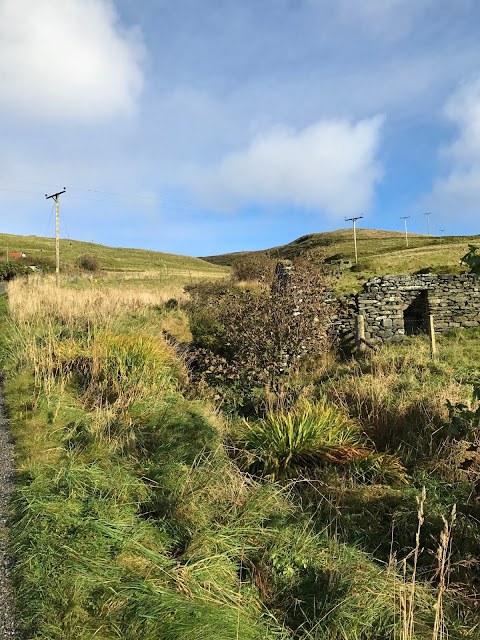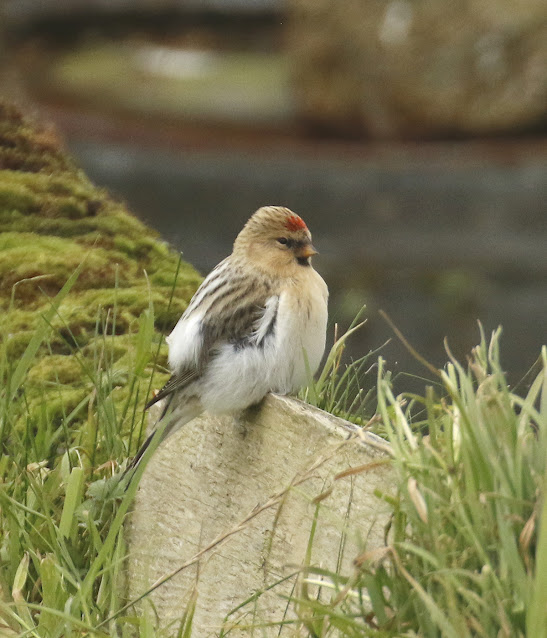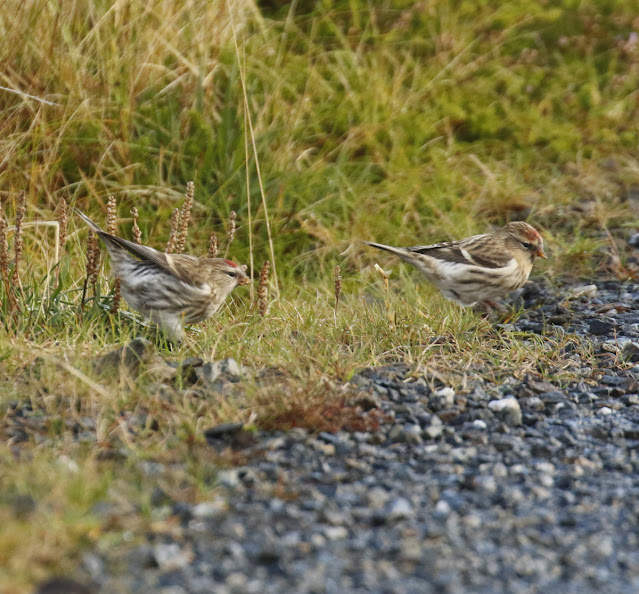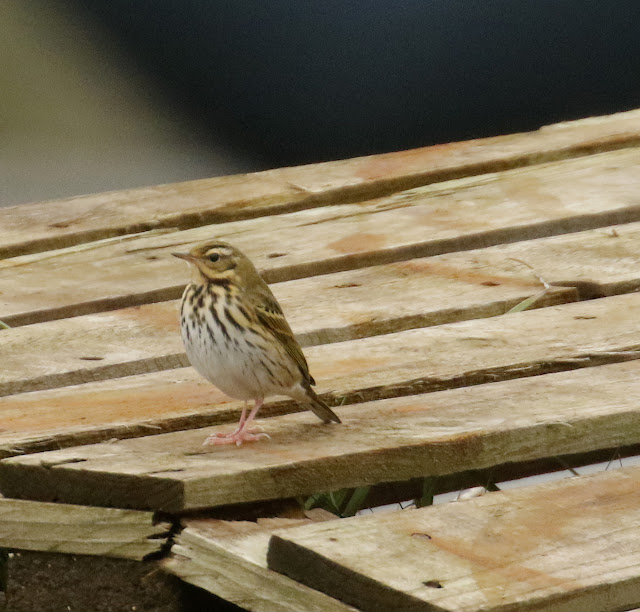Day 6
I did not sleep so well last night worrying about the wind and rain and some work issues that came back to haunt me in the wee hours. The wind was still very strong this morning but the rain showers mostly kept away and even when they did arrive were over quickly which seems to be a feature of the weather on Unst.
We made our traditional stop at Easter Loch to look at the Ring necked Duck, noting that the Tufted Ducks had increased to forty and there were now seven Eurasian Wigeon on the loch as well. The Whooper Swans had been joined by two more, bringing their total to seven also. Our plan was to walk around the roads, gardens and waste ground of Uyeasound to see if we could flush anything good from the bushes, rough grassland and ditches. It did not go well. In fact it was dire and all we could come up with was a single Willow Warbler, a couple of Blackcaps and a Brambling plus a soaking from an unexpected shower.
We decided to try a new area called Lund, an isolated spot with a neatly tended graveyard overlooking an isolated bay surrounded by moorland. On the way there we encountered our first Pink footed Geese, a small group of seven resting on some flooded ground by the road. Arriving at Lund we met a local birder who had just walked around the area and found nothing. His name was Robbie and he told us he had moved to Unst from England twenty years ago with his wife. As there were no birds to be seen we got talking as one does and it transpired he was originally from Stow on the Wold just five miles from my home in Kingham!
 |
| Lund Graveyard |
Most of the morning had now gone and so far we had seen very little but by some miracle we managed to make contact with the internet and found that a Hornemann's Arctic Redpoll had been found and reported at Skaw this very morning.
It did not take us long to get there and parking the car in the usual place we walked up to the back of the croft buildings where the redpoll, according to some departing birders, was showing very well. We joined a small line of ten or so birders looking over a dry stone wall into the backyard of the farm buildings.
Frustratingly the redpoll was currently out of sight feeding in the grass but then flew up and conveniently perched on a mossy wall.
 |
| Ready for action! |
 |
| The backyard of the croft |
 |
| Hornemann's Arctic Redpoll |
They really are beautiful and appealing birds with a pleasing demeanour. Their head is a delicate shade of buff with a bright scarlet patch on the forecrown, the buff extending down and around the face and neck onto the upper breast. It has a tiny yellow bill, so small it looks out of proportion to the head, and complemented by a black bib. The rest of the plumage is white and grey with darker streaks on the upperparts whilst the underparts are pure white. Most striking of all is the pure white back and rump which because of the bird's habit of fluffing it out is often very obvious.
 |
| 'Snowball' |
Reluctantly I left as it became more mobile around the buildings and walked up the hillside to where Donald and Colin were looking for the Red throated Pipit and there I met up with Geoff Wyatt and his elder brother who are also Oxonbirders. We had a chat and then they left for Valyie, where we planned to follow shortly after.
 |
| Signpost to Valyie - up the hill! |
 |
| Coue's Arctic Redpoll |
Lower down in the fields, in the ditches and along the fences were some Twite, a male Common Redstart, a couple of Common Chiffchaffs and Blackcaps, a Willow Warbler and a Lesser Whitethroat.
We bade farewell to Geoff who was going home tomorrow and moved on to a place called Northdale which comprised a couple of houses and some bushes. It looked good habitat but we could only find the usual Common Chiffchaffs and Blackcaps plus a lot of Skylarks in a field full of old fashioned corn stooks, something I have not seen for years.
 |
| Common Redstart |
We went on to Baltasound and entered 'The Final Destination', the local store, where we bought some more provisions and had a coffee.
Warmed up and revived we moved on for yet another reconnoitre of Halligarth Woods.One of the Spotted Flycatchers had departed but the other was still feeding from the fence wire. The wood was quiet with just a Willow Warbler, a Blackcap and a Lesser Whitethroat present. We walked along past various derelict buildings and checked bushes and hedges making our way towards Baltasound Post Office. Passing yet another derelict house with some wind blown small trees in its backyard we flushed two redpolls from the trees which flew a short distance to land on a dry stonewall and commenced feeding on dead grasses.They were very white and on getting closer we could see they were Arctic Redpolls and were small, smaller than the Hornemann's Redpoll we had seen earlier in the day, so they could only be Coue's Arctic Redpolls and very pleasing it was too, finding yet more of our own Arctic Redpolls. They fed for fifteen minutes and then flew back towards the derelict house. I should add that there has been some mild controversy about the sub specific identity of these birds with some saying they are Hornemann's and others including us saying they are Coue's Arctic Redpolls.
 |
| Coue's Arctic Redpolls |
We resolved to return tomorrow to check it out as now the light was fading fast.Time to return to the hostel.
Day 7
At last! As I awoke I realised it was strangely still outside and the wind had dropped to an acceptable level. I was feeling tired having stayed up until after midnight chewing the fat with John and Wee George and drinking too much red wine. It really was quite pleasant outside with some weak sunshine brightening the sky and today Colin would be leaving us to catch the night ferry from Lerwick to Aberdeen, but before he did we planned one more visit to Skaw to try and see the Hornemann's Arctic Redpoll and the Red throated Pipit. When we got to Skaw we could find no sign of the redpoll and by common consent we decided on not looking for the pipit as there were a lot of birders wandering around the hillside and the pipit would just be constantly flushed and no one would get good views of it.
At last! As I awoke I realised it was strangely still outside and the wind had dropped to an acceptable level. I was feeling tired having stayed up until after midnight chewing the fat with John and Wee George and drinking too much red wine. It really was quite pleasant outside with some weak sunshine brightening the sky and today Colin would be leaving us to catch the night ferry from Lerwick to Aberdeen, but before he did we planned one more visit to Skaw to try and see the Hornemann's Arctic Redpoll and the Red throated Pipit. When we got to Skaw we could find no sign of the redpoll and by common consent we decided on not looking for the pipit as there were a lot of birders wandering around the hillside and the pipit would just be constantly flushed and no one would get good views of it.
So it was decided to go to nearby Northwick and Valyie and on the way we found two Mealy Redpolls feeding by the side of the road and no less than four Northern Wheatears, each bird standing sentinel on top of a fence post.
 |
| Mealy Redpolls |
 |
| The gully beside the road leading up to Valyie |
Donald got busy chatting to a local birder up by Valyie so Colin and myself walked back down the road to where we had seen the Little Bunting land earlier. Right in a secluded corner we flushed it and it flew to a bare tree not too far away in a garden which at last gave us reasonably extended views of it before it flew off further.
 |
| A very distant Little Bunting |
The pipit flew up from the grass giving its distinctive call and settled close to the shoreline. We walked slowly after it and it flew again, in a circle round us, to land in the grass. A couple of Meadow Pipits in the same area caused some initial confusion but by careful stalking we got to see it regularly and well, especially when it perched openly on a fence or rock. It was boldly marked on its face and with prominent black streaks on its buff breast whilst its upperparts were olive brown and almost unmarked. Most noticeable were its bright pink legs and feet. In the grass it was virtually invisible and could move with surprising speed, unseen, though the grass so you were never quite certain where it would appear next.
 |
| Olive backed Pipit |
Returning to Baltasound Post Office to check the field with the unidentified Acrocephalus warbler in it and on getting much better views of it this time, we were satisfied it was a Reed Warbler. A flock of Mealy Redpolls landed in the small trees bordering the field and four Red breasted Mergansers swam offshore. We left soon after as we had to take Colin back to the hostel to collect his car and possessions before he drove back to Lerwick to catch the ferry.
With access to the internet at the hostel we learned that a White's Thrush had been found on Fair Isle today. Would that something so good would arrive on Unst!
 |
| Colin and yours truly |
 |
| On the beach at Westing |
A final visit to Halligarth Wood revealed nothing of note except the lone Spotted Flycatcher still hanging on in its usual place on the fence wire.
to be continued ........
































No comments:
Post a Comment